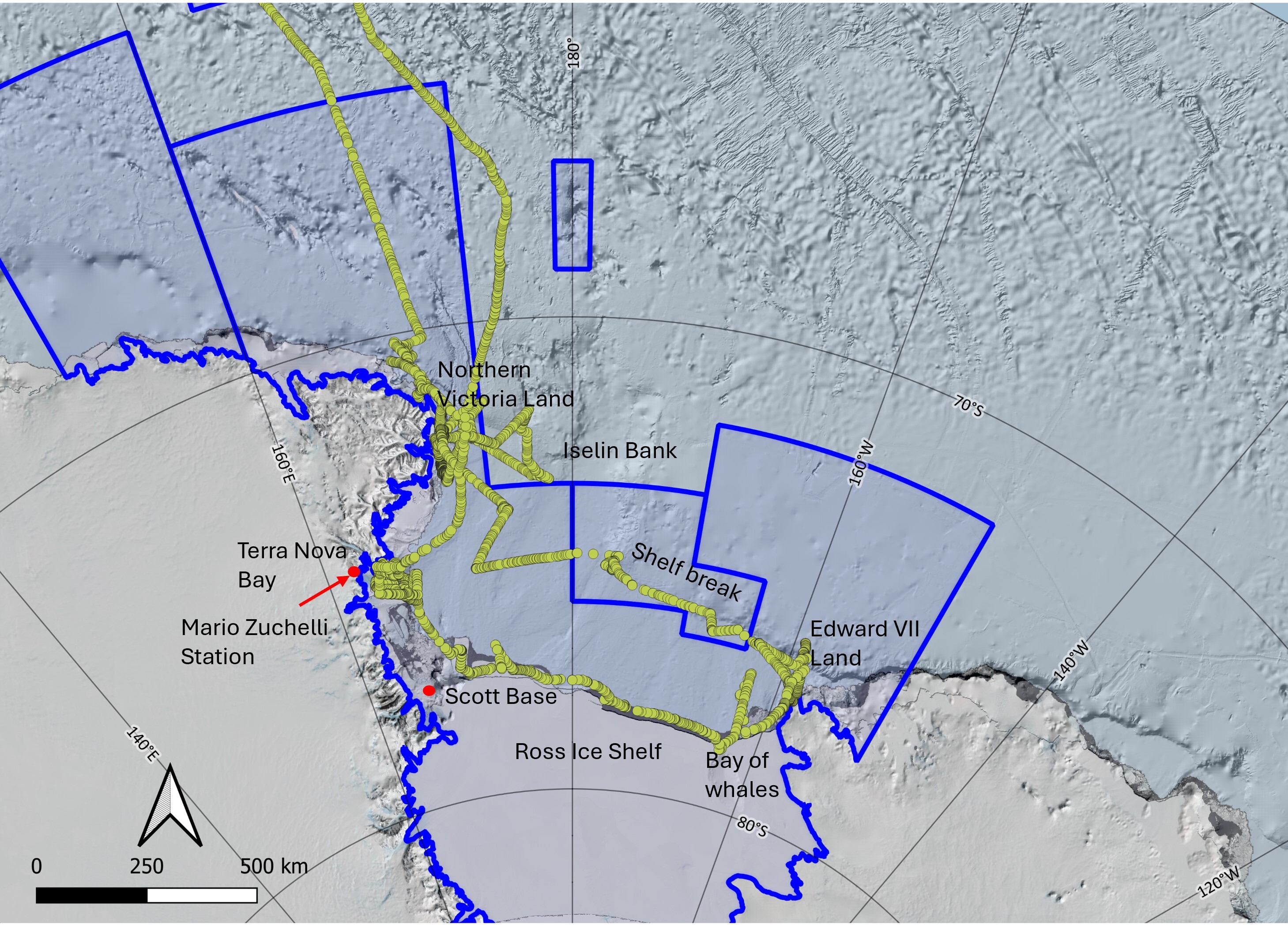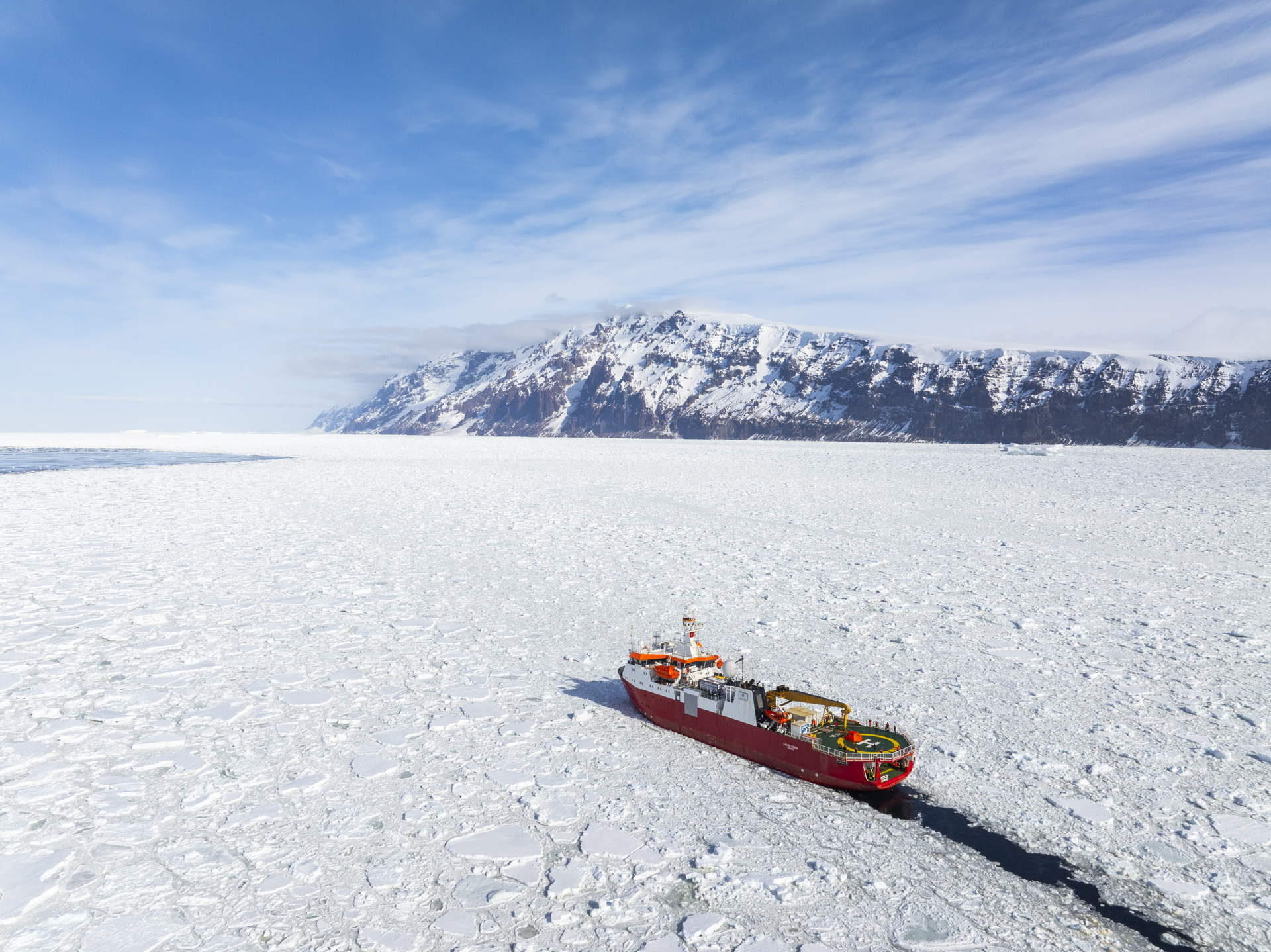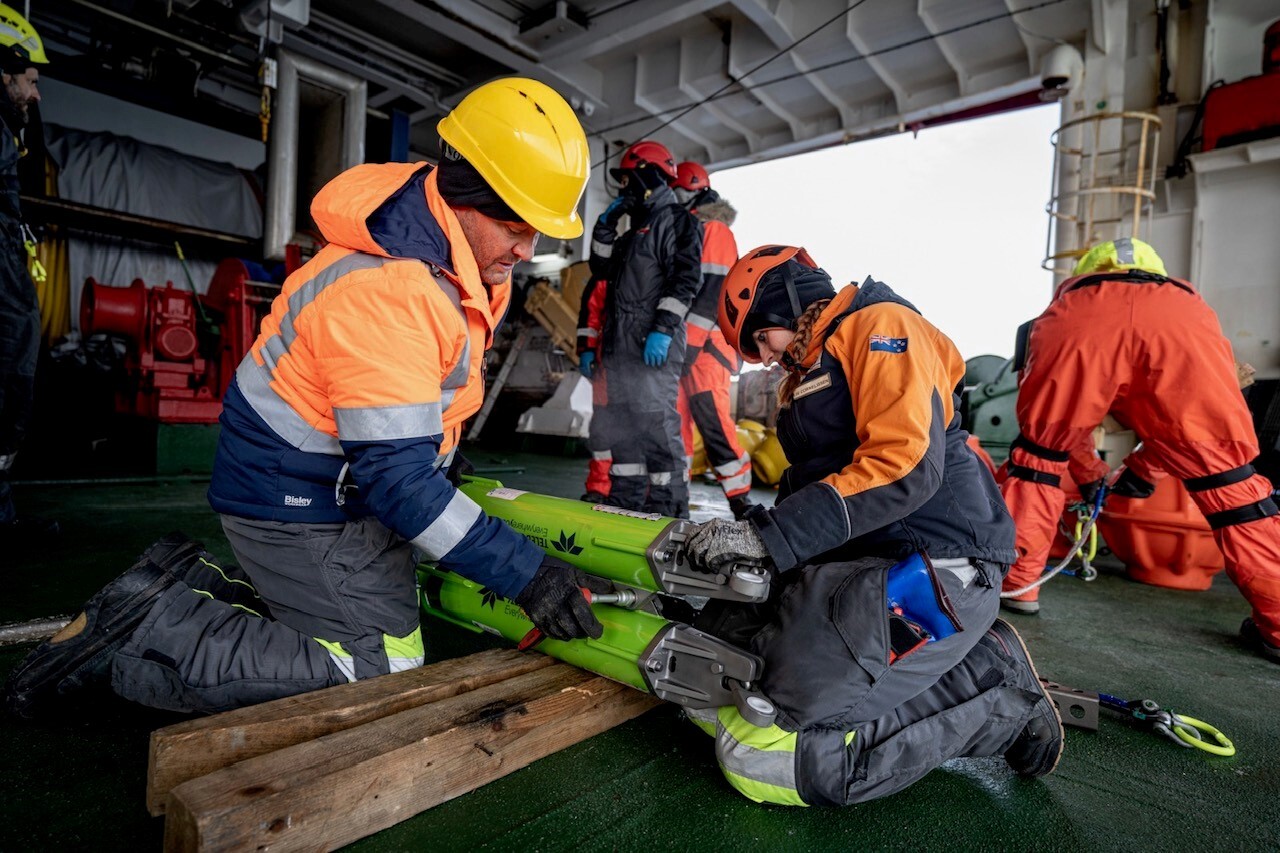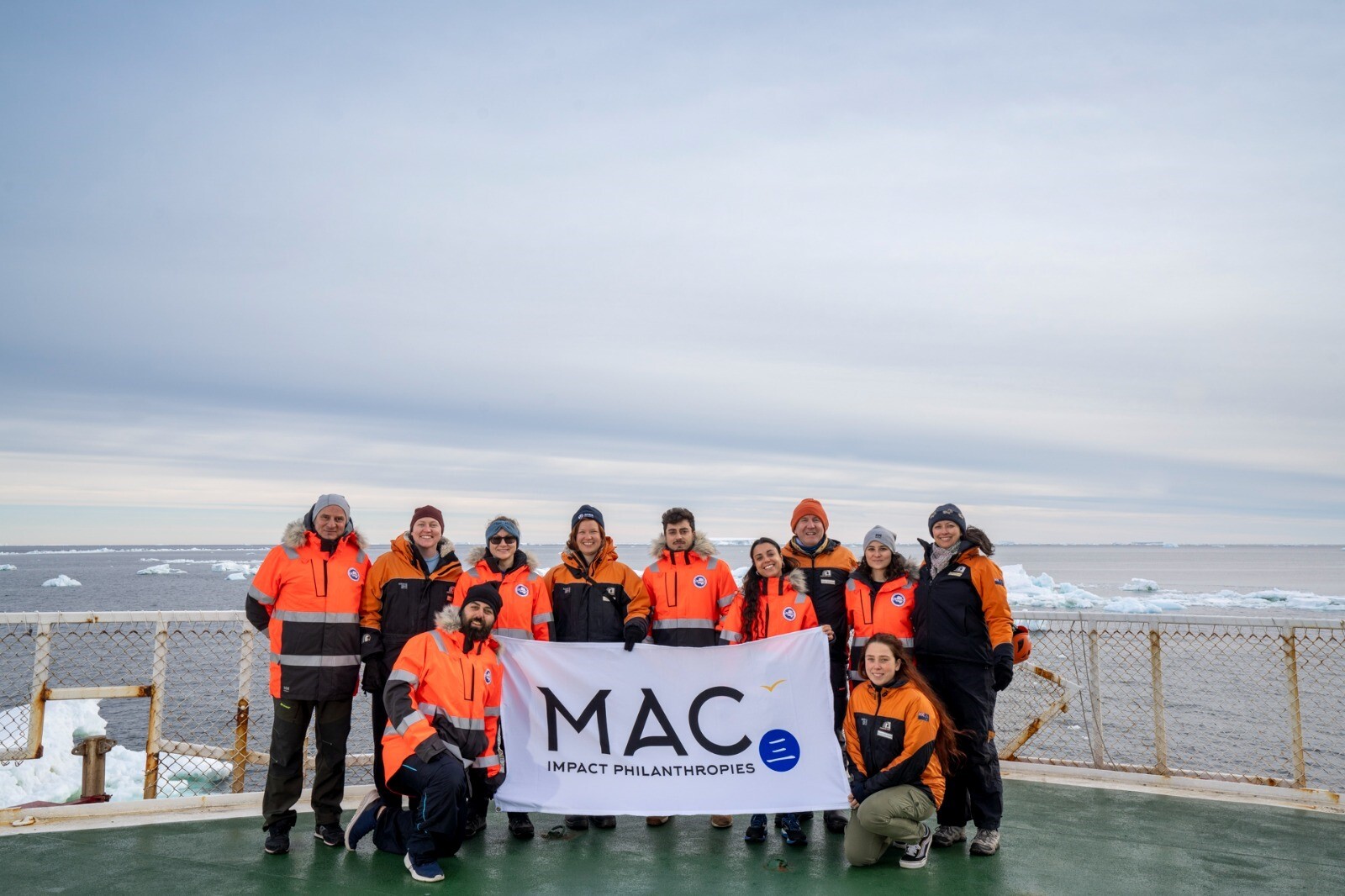
Ross Sea Voyage 2024
The Antarctic Science Platform is collaborating with the Italian Antarctic Research Programme on a voyage to the Ross Sea in Antarctica. In January 2024, twelve members of the New Zealand team will join Italian colleagues on the RV Laura Bassi for a two-month voyage of discovery.
Voyage track
Our team will spend two months at sea, witnessing sea-ice retreat firsthand.
The planned voyage track is anti-clockwise around the Ross Sea.
The RV Laura Bassi departed from the Port of Lyttelton, New Zealand, on 6 January. It entered the Ross Sea at the western side a week later, working along the Victoria Land Coast and in Terra Nova Bay.
The ship called in at the Italian Antarctic research station, Mario Zuchelli, to collect scientists who had flown in from McMurdo Station/Scott Base.
The vessel is then transiting along the front of the Ross Ice Shelf, then north and west along the continental shelf break.
Our team aims to arrive in Lyttelton on about 3 March.
You can follow the RV Laura Bassi's 39th PNRA Antarctic Campaign in real-time on ship operator OGC's web site

The track of the Laura Bassi in Antarctica, position data kindly provided by Starboard Maritime Intelligence, Starboard.nz The Ross Sea region Marina Protected Area (MPA) is outlined in blue.
Voyage Updates
Follow our journey through updates from New Zealand's voyage leader, Dr Craig Stevens.
Ross Sea Voyage Update #1: Leaving Lyttelton 6 January 2024
Ross Sea Voyage Update #2: Crossing the Line 12 January 2024
Ross Sea Voyage Update #3: Terra Nova Bay 21 January 2024
Ross Sea Voyage Update #4: Katabatic winds 27 January 2024
Ross Sea Voyage Update #5: Traversing the Ross Ice Shelf 1 February 2024
Ross Sea Voyage Update #6: The Bay of Whales 4 February 2024
Ross Sea Voyage Update #7: Cape Colbeck & King Edward VII Land 8 February 2024
Ross Sea Voyage Update #8: Along the continental shelf break 11 February 2024
Ross Sea Voyage Update #9: Sheltering in the sea ice 21 February 2024
Ross Sea Voyage Update #10: Sea ice, sunsets and science 22 February 2024
Ross Sea Voyage Update #11: Robertson Bay 25 February 2024
Ross Sea Voyage Update #12: Crossing the Antarctic Circumpolar Current 1 March 2024

RV Laura Bassi. Photo: Lana Young
Voyage Science
The New Zealand science plan has three key objectives.
Ross Sea Polynya
Polynya are sea ice production factories. They are (i) difficult places to make measurements and (ii) poorly represented in climate models – and knowledge of them is critical at a time of rapidly declining sea ice. Our goal for the voyage is to deploy state of the art sensors designed to operate and gather information over a range of spatial and temporal scales, to develop new knowledge of Antarctica’s most productive polynya – the Ross Sea Polynya.
Ross Sea region Marine Protected Area (MPA)
We will use a range of current research tools, including isotopic analysis, gene-scaping, eDNA, acoustics, gathering of key environmental measurements, and deployment of ROVs and ocean gliders, to study Ross Sea pelagic and benthic (coastal) ecosystems. This data will be used, along with existing and future research, to establish a baseline of the Ross Sea region MPA ecosystem function and coastal biodiversity to determine how vulnerable this ecosystem is to the future changes anticipated for this region.
Seabed coring
An important aspect of Platform research is to use sediment records to better understand how the Ross Sea responded to historic climatic conditions. Knowing how sea ice was distributed, and how that impacted on primary production at times when the climate was naturally warmer can inform predictions of how things will respond when such conditions return. To support this research, we aim to collect and analyse shallow cores along the front of the Ross Ice Shelf, areas that we have seldom visited, to enhance existing transfer functions.

Preparing acoustic releases for a mooring. Photo: Lana Young
Growing Antarctic careers
We are creating inter-generational knowledge in real time.
The New Zealand-Italy research voyage provides an opportunity for Early Career Researchers (ECR) and postgraduate students. The New Zealand contingent includes five ECRs and four PhD students.
MAC3 Impact Philanthropies have provided funding to facilitate New Zealand and Italian ECRs with a passion for Antarctica to use the 2024 Ross Sea Voyage to grow their Antarctic research careers. The recipients will put this support, after the voyage is completed, towards expenses for research time, for undertaking additional lab analyses, producing high quality publications, media engagement and conference travel.
The joint voyage provides an exciting opportunity to build a cohort of Antarctic ECRs.

A world-wide collaboration
The following organisations are providing funding, personnel or equipment for the voyage:
Antarctica New Zealand
Antarctic Science Platform
British Antarctic Survey
Fisheries and Oceans Canada
Istituto Nazionale di Oceanografia e di Geofisica Sperimentale (OGS)
MAC3 Impact Philanthropies
Monash University
National Institute of Water & Atmospheric Sciences (NIWA)
Programma Nazionale di Ricerche in Antartide (PNRA)
Te Herenga Waka - Victoria University of Wellington
University of Otago | Te Whare Wānanga o Otāgo
University of Waikato | Te Whare Wananga o Waikato
Meet the team
Craig Stevens (NIWA) – Voyage Leader, Ross Sea Polynya
Jasmin McInerney (NIWA) - Ross Sea Polynya
Craig Stewart (NIWA) - Ross Sea Polynya
Liv Cornelissen (University of Auckland / NIWA) - Ross Sea Polynya
Christina Riesselman (University of Otago) – Seabed coring
Meghan Duffy (University of Otago) – Seabed coring
Luisa Fontanot (University of Otago) – Seabed coring
Svenja Halfter (NIWA) – Marine ecology: zooplankton
Georgia Pollard (University of Waikato) – Marine ecology: zooplankton
Alina Madita Wieczorek (NIWA) – Marine ecology: acoustics
Gert-Jan Jeunen (University of Otago) – Marine ecology: DNA/benthos
Matthias Dehling (Monash University) – Marine ecology: seabirds
Lana Young (NIWA) – Videographer & Science Communicator

Back row. (left to right) Gianluca Colorito, Pasquale Castagno, Paola Rivaro, Giovanni Zambardino, Alessio Andreani, Craig Stevens, Giuseppe Asaro, Gianpaolo Visnovic, Giacomo Prato, Alessandro Bubbi, Massimiliano Esposito, Filippo Azzaro, Andrea Cova, Arturo De Alteris, Simone di Palma, Fabrizio Zgur, Francisco Ardini, Stefano Kuchler, Pierpaolo Falco, Svenja Halfter, Mathias Dehling, Ciro Rappazzo, Davide Siciliano, Giovanni Valastro.
Middle row. (left to right) Angela Garzia, Emilio Femiano, Cecilia Balestra, Benedetta Beltramelli, Roberto Romeo, Daniela Accettella, Alina Wieczorek, Liv Cornelissen, Luisa Fontanot, Naomi Krauzig, Meghan Duffy, Salvatore Napoli, Antonio Sposito, Antonio Sannino, Claudio Ingalisi, Salvatore Marino, Luigi Verde, Francesco Bellettini, Franco Sedmak, Diego De Nardi
Front row (kneeling) Lana Young, Jasmin McInerney, Georgia Pollard, Craig Stewart, Nancy Lucà, Massimo De Stefano, Mauro Celussi, Giuseppe Balsamo. Photo: Lana Young.
Media
- Voyage to solve the mystery of Antarctica's plummeting sea ice - Stuff
- New Zealand scientists return from Antarctica's ice with information that could shape future climate policy - Newshub
- Signs found of worryingly fast Antarctic ice melt - RNZ, Newstalk ZB, TVNZ
- United Nations sounds 'Red Alert' as world smashes every major global climate record - Newshub
- The Detail podcast: The sea ice factories of Antarctica, 23'24" - Radio New Zealand, Newsroom
- Antarctica's sea ice hit another low this year - understanding how ocean warming is driving the loss is key - The Conversation
For media inquiries, please contact d.diaz@antarcticanz.govt.nz